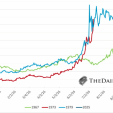Gold Price Bounces. Is This A Trend Reversal?
New York (Nov 9) Gold was trading sharply higher on Friday after the US monthly jobs report showed fewer jobs were added in the economy than expected. This encouraged traders to take some profit on their long dollar positions, causing buck-denominated assets to rally. But we remain skeptical how high gold can go from here, for the jobs report wasn’t that bad. After all, the unemployment rate edged lower to 5.8% thanks to another 200-thousand-plus increase in non-farm employment. Ignoring today’s bounce, gold has dropped to a low so far of just under $1132 per troy ounce since reaching $1255 about three weeks ago.
To put things into perspective, it has fallen almost 10% during this period, which is obviously a huge move. Most of the losses have been due to the US dollar, which has surged higher following last week’s hawkish FOMC statement and increasingly more dovish central banks elsewhere in G10. The Bank of Japan’s surprise decision to expand its asset purchases program last week was followed by a dovish European Central Bank meeting on Thursday. At the follow up monthly news conference, Mario Draghi said the ECB is prepared to act more aggressively to combat deflation threats if needed and that the policy makers were unanimous on this view. He also said that the ECB’s Governing Council expects the central bank’s balance sheet to reach the early 2012 levels, implying an increase of up to €1 trillion. The net effect of the BoJ and ECB announcements has been positive for not only the US dollar, but also the global equity markets. Thus this has weighed on safe-haven demand.
But given that gold has also fallen even in euro terms recently, the dollar alone cannot explain its weakness. It seems therefore that investors are not finding any value, at least at these levels, in tying up a significant portion of their capital in gold. What’s more, the physical demand for gold has also not been as strong as it had been in recent past. Price pressures remain weak across the globe so there is less need inflation hedging purposes at this moment. On top of this, the world’s top gold consumers – China and India – have been purchasing less gold. The Chinese are probably waiting for prices to fall further before increasing their purchases. Perhaps one piece of positive news for gold bugs is that prices are now close to the cost of production levels, therefore miners will be forced to halt production if they fall further and remain depressed. The potential reduction in supply growth could provide support to prices. But in the more near-term outlook, one other positive news is that the falling prices have given rise to bullion coin and bar sales, especially in North America. What’s more, the market sentiment is VERY bearish on precious metals and this is should be a warning sign for the bears that the trend may soon end.
Gold’s breakdown of the key $1180 support level last week has given rise to follow-up technical selling. The yellow metal has already reached both of our targets from last week: the 127.2% and 161.8% Fibonacci extension levels of the last rally that started at the beginning of October, at $1163 and $1138/9 respectively. Therefore Friday’s bounce was also driven by profit-taking which is part of the reason why we don’t think the rally will be sustained. Even if it does push further higher, it would do really well reach, let alone break, the $1180 level. For as long as it remains below this broken support level, our technical outlook on gold will remain bearish. Meanwhile the 127.2% extension of a separate move, the short-lived rally from the 2013 low comes is at the psychological $1111.1 level. This is our extended bearish target.
Source: GoldSilverWorlds












